A 36-Pulse Diode Rectifier with an Unconventional Interphase Reactor
Abstract
:1. Introduction
2. Proposed 36-Pulse Rectifier with Unconventional IPR
3. Operation Mode and Optimal Design of Unconventional IPR
3.1. Operation Mode
- (1)
- The load of proposed rectifier is a large inductance loading and the load current id can be view as a constant Id.
- (2)
- The leakage inductances and resistances of autotransformer and unconventional IPR are neglected.
- (3)
- Assume that the input voltage of the proposed 36-pulse rectifier is:where Um is the amplitude of the input phase voltage, ω is the angular frequency of the input phase voltage.
- (4)
- Assume that the voltage across the secondary winding of the unconventional IPR is us, and the load voltage is ud. The output voltage of the two three-phase diode-bridge rectifiers is ud1 and ud2, respectively.
3.2. Necessary Condition
3.3. Optimal Parameters Design
3.4. KVA Rating of the Unconventional IPR
3.5. KVA Rating of the ZSBT
4. Experimental Results
5. Conclusions
Author Contributions
Funding
Conflicts of Interest
References
- Rodriguez, J.; Pontt, J.; Silva, C.; Wiechmann, E.; Hammond, P.; Santucci, F.W.; Álvarez, R.; Musalem, R.; Kouro, S.; Lezana, P. Large current rectifiers: State of the art and future trends. IEEE Trans. Ind. Electron. 2005, 52, 738–746. [Google Scholar] [CrossRef]
- Singh, B.; Gairola, S.; Singh, B.; Chandra, A.; Al-Haddad, K. Multipulse AC-DC converters for improving power quality: A review. IEEE Trans. Power Electron. 2008, 23, 260–281. [Google Scholar] [CrossRef]
- Das, J. Harmonic Reduction at the Source; IEEE Press: New York, NY, USA, 2015. [Google Scholar]
- Prakash, P.S.; Kalpana, R.; Singh, B.; Bhuvaneswari, G. A 20-pulse asymmetric multiphase staggering autoconfigured transformer for power quality improvement. IEEE Trans. Power Electron. 2018, 33, 917–925. [Google Scholar]
- Choi, S.; Lee, B.; Enjeti, P. New 24-pulse diode rectifier systems for utility interface of high-power AC motor drives. IEEE Trans. Ind. Appl. 1997, 33, 531–541. [Google Scholar] [CrossRef]
- Abdollahi, R.; Gharehpetian, G. Inclusive design and implementation of novel 40-pulse ac-dc converter for retrofit application and harmonic mitigation. IEEE Trans. Ind. Electron. 2016, 63, 667–677. [Google Scholar] [CrossRef]
- Khan, S.; Zhang, X.; Saad, M.; Ali, H.; Khan, B.; Zaman, H. Comparative analysis of 18-pulse autotransformer rectifier unit topologies with intrinsic harmonic current cancellation. Energies 2018, 11, 1347. [Google Scholar] [CrossRef]
- Singh, B.; Bhuvaneswari, G.; Garg, V. T-connected autotransformerbased 24-pulse AC–DC converter for variable frequency induction motor drive. IEEE Trans. Energy Convers. 2006, 21, 663–672. [Google Scholar] [CrossRef]
- Mon-Nzongo, D.L.; Ipoum-Ngome, P.G.; Jin, T.; Song-Manguelle, J. An improved topology for multipulse AC/DC converters within HVDC and VFD systems: Operation in degraded Modes. IEEE Trans. Ind. Electron. 2018, 65, 3646–3656. [Google Scholar] [CrossRef]
- Yang, T.; Bozhko, S.; Asher, G. Functional modeling of symmetrical multipulse autotransformer rectifier units for aerospace applications. IEEE Trans. Power Electron. 2015, 30, 4704–4713. [Google Scholar] [CrossRef]
- Singh, B.; Bhuvaneswari, G.; Kalpana, R. Autoconnected transformer based 18-pulse ac-dc converter for power quality improvement in switched mode power supplies. IEEE Trans. Power Electron. 2010, 3, 525–541. [Google Scholar] [CrossRef]
- Meng, F.; Yang, W.; Zhu, Y.; Gao, L.; Yang, S. Load adaptability of active harmonic reduction for 12-pulse diode bridge rectifier with active interphase reactor. IEEE Trans. Power Electron. 2015, 30, 7170–7180. [Google Scholar] [CrossRef]
- Biela, J.; Hassler, D.; Schönberger, J.; Kolar, J.W. Closed-loop sinusoidal input-current shaping of 12-pulse autotransformer rectifier unit with impressed output voltage. IEEE Trans. Power Electron. 2011, 26, 249–259. [Google Scholar] [CrossRef]
- Sandoval, J.J.; Krishnamoorthy, H.S.; Pitel, I. Reduced active switch front-end multipulse rectifier with medium-frequency transformer isolation. IEEE Trans. Power Electron. 2017, 32, 7458–7468. [Google Scholar] [CrossRef]
- Young, C.; Chen, M.; Lai, C.; Shih, D. A novel active interphase transformer scheme to achieve three-phase line current balance for 24-pulse converter. IEEE Trans. Power Electron. 2012, 27, 1719–1731. [Google Scholar] [CrossRef]
- Pan, Q.; Ma, W.; Liu, D.; Zhao, Z.; Meng, J. A new critical formula and mathematical model of double-tap interphase reactor in a six-phase tap-changer diode rectifier. IEEE Trans. Ind. Electron. 2007, 54, 479–485. [Google Scholar]
- Meng, F.; Yang, S.; Yang, W. Modeling for a multitap interphase reactor in a multipulse diode bridge rectifier. IEEE Trans. Power Electron. 2009, 24, 2171–2177. [Google Scholar] [CrossRef]
- Singh, B.; Garg, V.; Bhuvaneswari, G. Polygon-connected autotransformer-based 24-pulse AC–DC converter for vector-controlled induction-motor drives. IEEE Trans. Ind. Electron. 2008, 55, 197–208. [Google Scholar] [CrossRef]
- Yang, S.; Wang, J.; Yang, W. A Novel 24-Pulse Diode Rectifier with an Auxiliary Single-Phase Full-Wave Rectifier at DC Side. IEEE Trans. Power Electron. 2017, 32, 1885–1893. [Google Scholar] [CrossRef]
- Chivite-Zabalza, F.J.; Forsyth, A.J.; Araujo-Vargas, I. 36-Pulse Hybrid Ripple Injection for High-Performance Aerospace Rectifiers. IEEE Trans. Ind. Appl. 2009, 45, 992–999. [Google Scholar] [CrossRef]
- Li, X.; Xu, W.; Ding, T. Damped high passive filter—A new filtering scheme for multipulse rectifier systems. IEEE Trans. Power Deliv. 2017, 32, 117–124. [Google Scholar] [CrossRef]
- Paice, D.A. Power Electronic Converter Harmonic Multipulse Methods for Clean Power; IEEE Press: New York, NY, USA, 1996. [Google Scholar]
- Meng, F.; Gao, L.; Yang, S.; Yang, W. Effect of phase-shift angle on a delta-connected autotransformer applied to a 12-pulse rectifier. IEEE Trans. Ind. Electron. 2015, 62, 4678–4690. [Google Scholar] [CrossRef]
- Meng, F.; Yang, W.; Yang, S. Effect of voltage transformation ratio on the kilovoltampere rating of delta-connected autotransformer for 12-pulse rectifier system. IEEE Trans. Ind. Electron. 2013, 60, 3579–3588. [Google Scholar] [CrossRef]
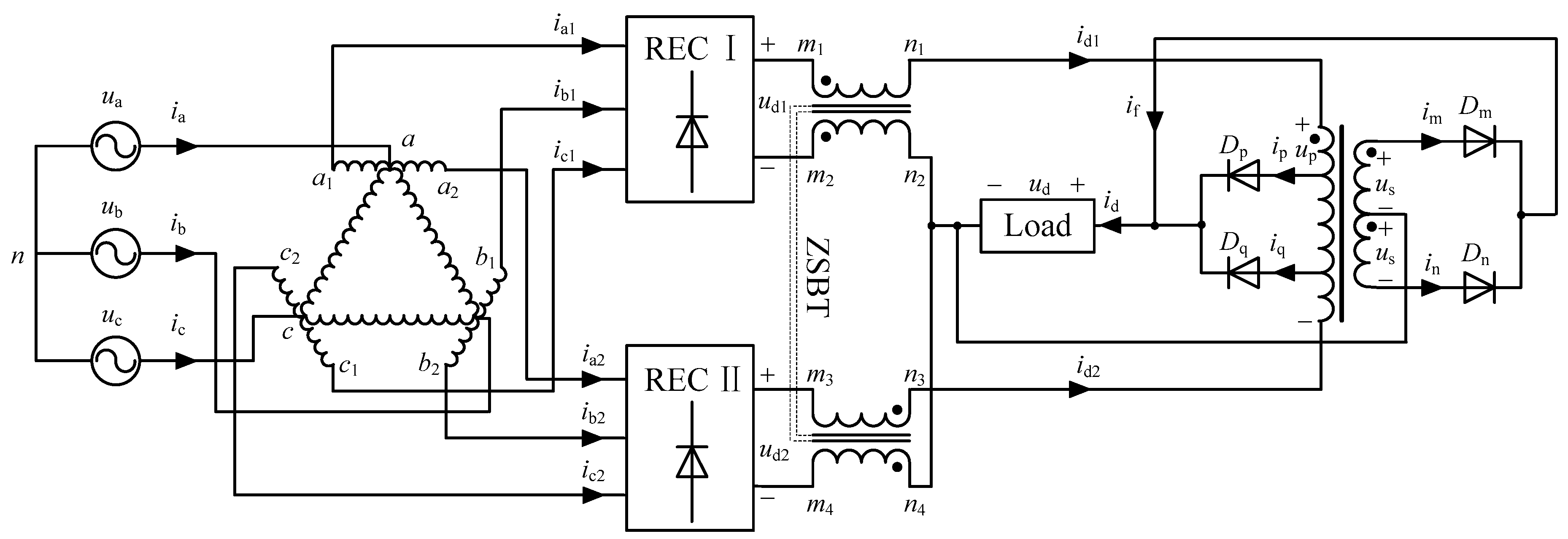




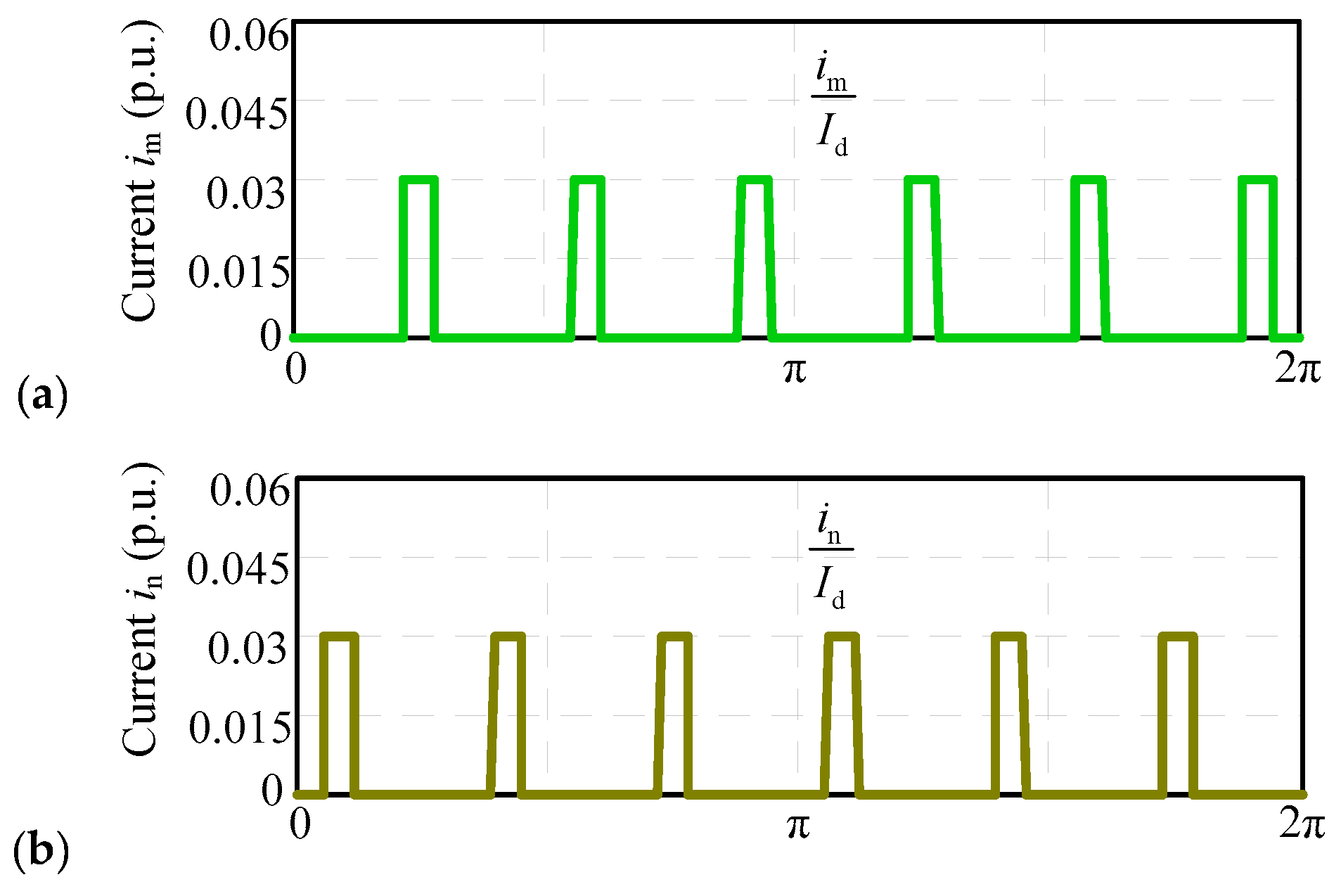

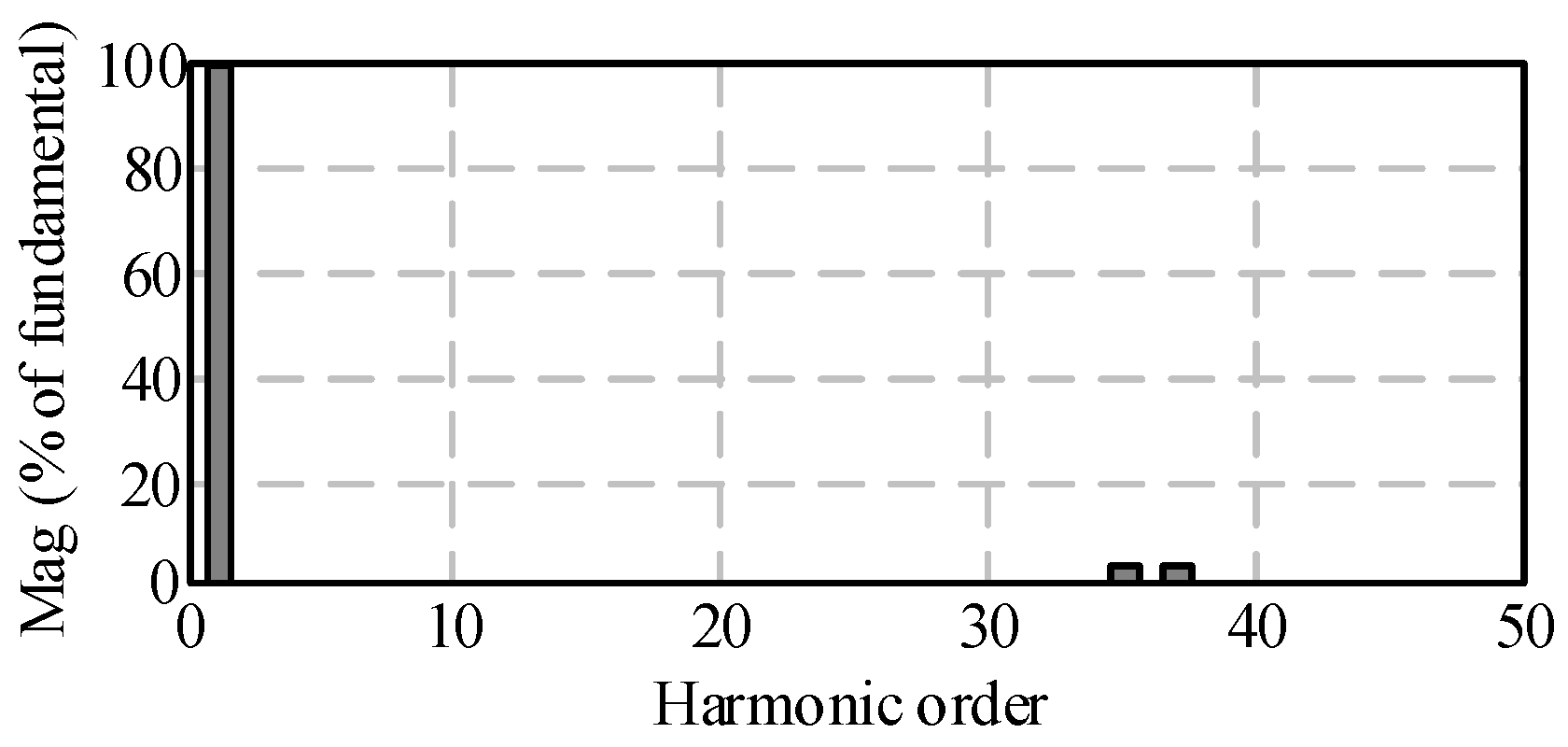
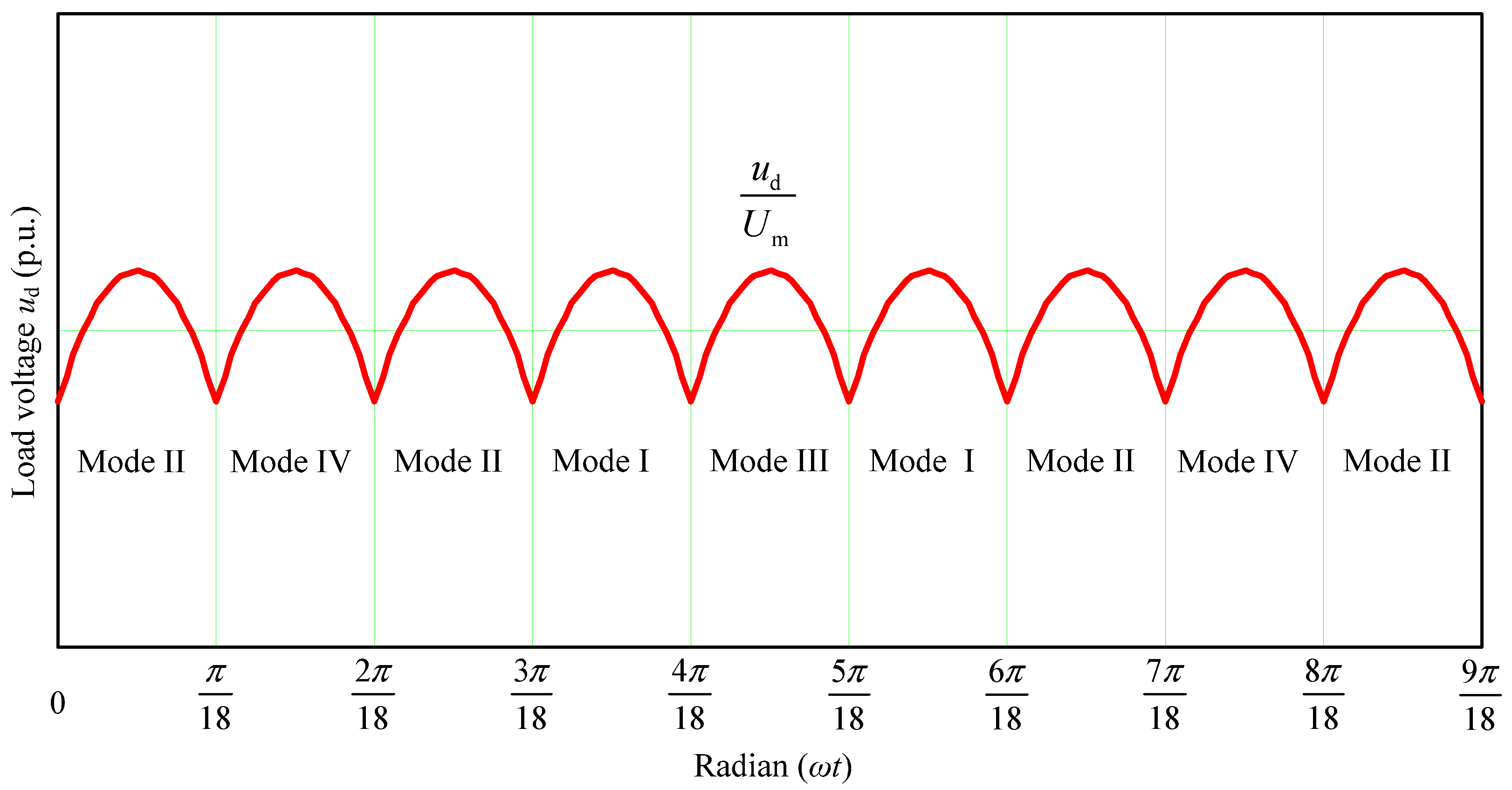
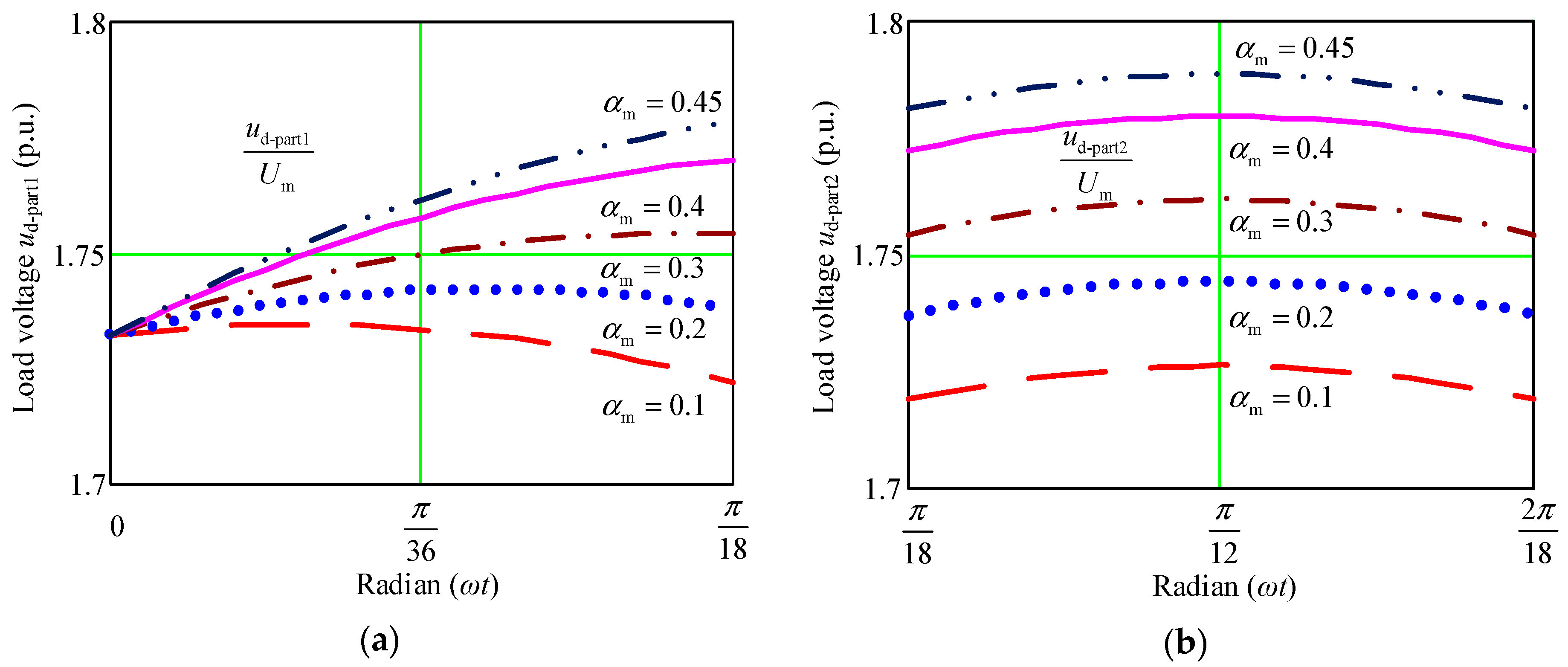
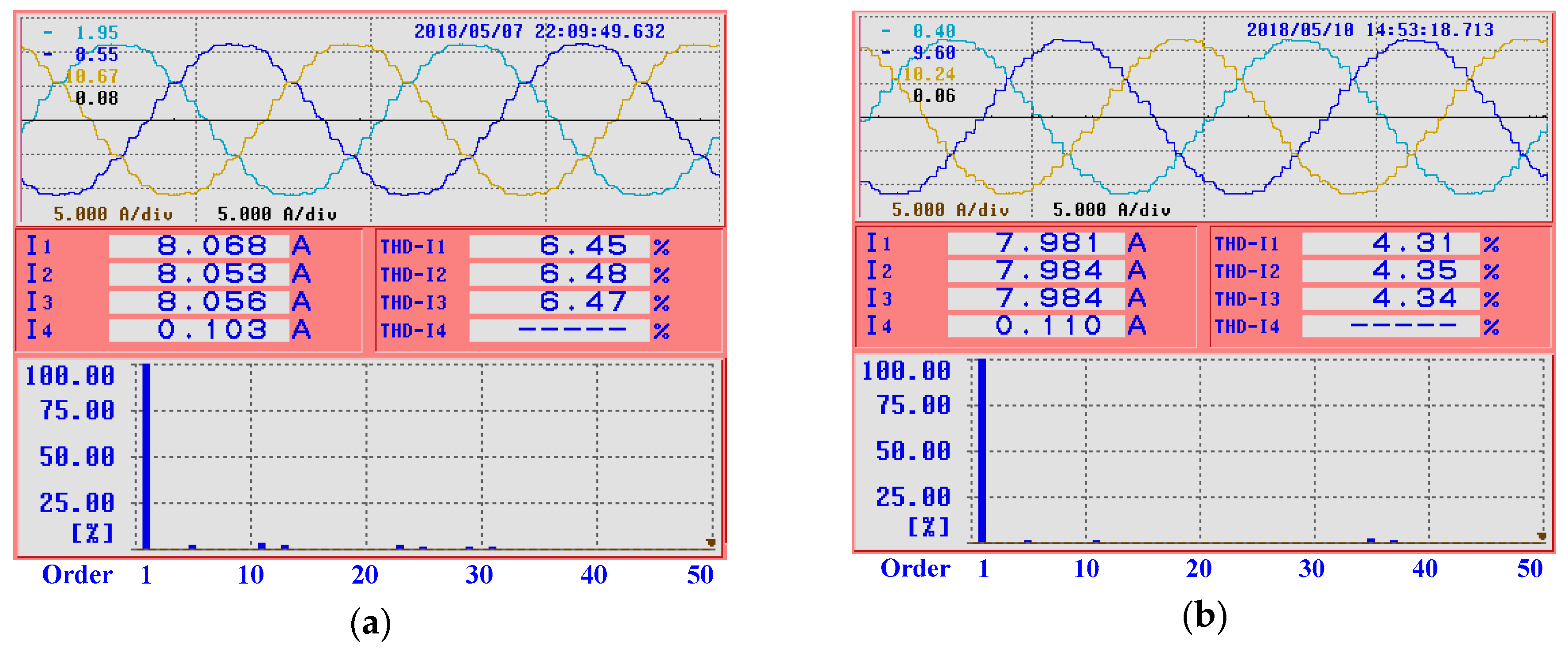


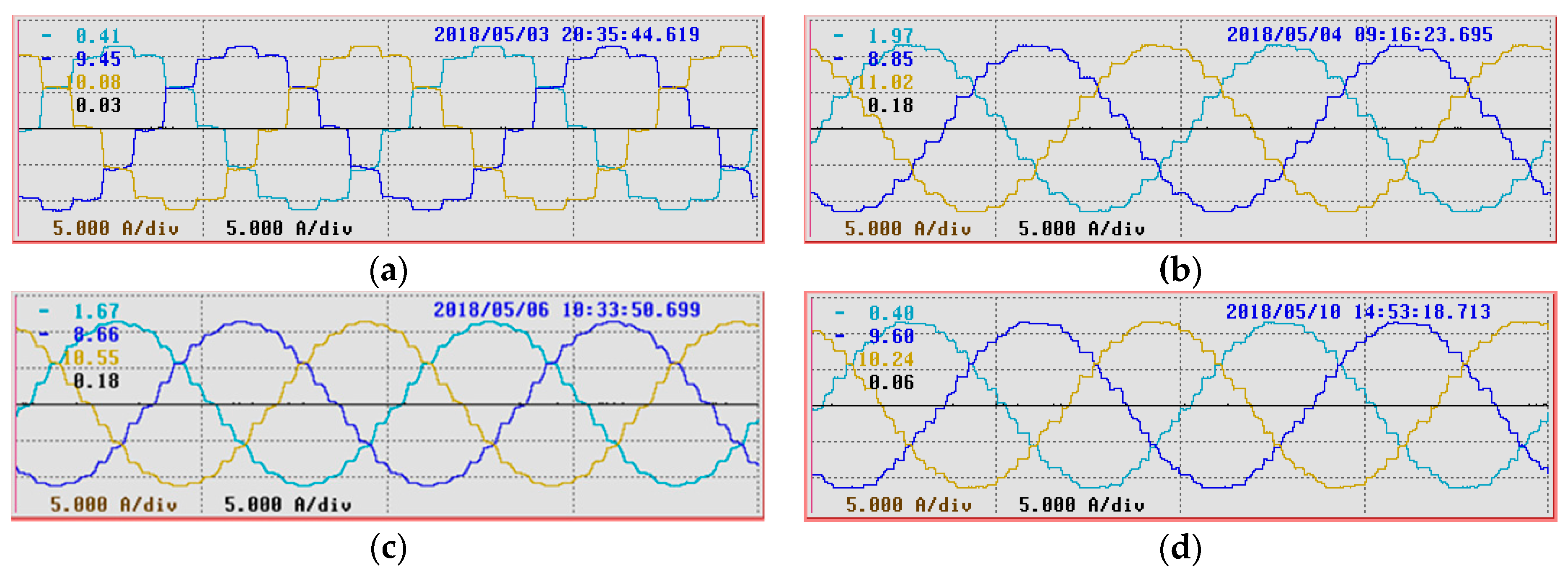
| Parameter | Value |
|---|---|
| Input phase voltage (rms) | 120 V |
| Line frequency | 50 Hz |
| Load filtering inductance | 10 mH |
| Primary tapped ratio (αm) of the unconventional IPR | 0.16 |
| Turn ratio (αn) of the unconventional IPR | 10.74 |
| Rated output power | 3 kW |
| Rated output current | 10 A |
| Topologies | Input line Current THD | IPR kVA Rating | Load Power | Efficiency |
|---|---|---|---|---|
| 12-pulse rectifier with conventional IPR | 12.23% | 2.04% UdId | 2932.1 W | 96% |
| 24-pulse rectifier with double-tapped IPR | 5.93% | 1.65% UdId | 2941.2 W | 96.3% |
| 24-pulse rectifier with unconventional IPR | 5.62% | 3.11% UdId | 2944.3 W | 96.4% |
| 36-pulse rectifier with unconventional IPR | 4.34% | 2.60% UdId | 2965.6 W | 97.1% |
© 2019 by the authors. Licensee MDPI, Basel, Switzerland. This article is an open access article distributed under the terms and conditions of the Creative Commons Attribution (CC BY) license (http://creativecommons.org/licenses/by/4.0/).
Share and Cite
Lian, Y.; Yang, S.; Ben, H.; Yang, W. A 36-Pulse Diode Rectifier with an Unconventional Interphase Reactor. Energies 2019, 12, 820. https://doi.org/10.3390/en12050820
Lian Y, Yang S, Ben H, Yang W. A 36-Pulse Diode Rectifier with an Unconventional Interphase Reactor. Energies. 2019; 12(5):820. https://doi.org/10.3390/en12050820
Chicago/Turabian StyleLian, Yuxin, Shiyan Yang, Hongqi Ben, and Wei Yang. 2019. "A 36-Pulse Diode Rectifier with an Unconventional Interphase Reactor" Energies 12, no. 5: 820. https://doi.org/10.3390/en12050820





